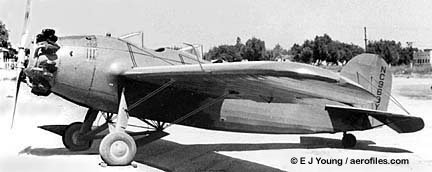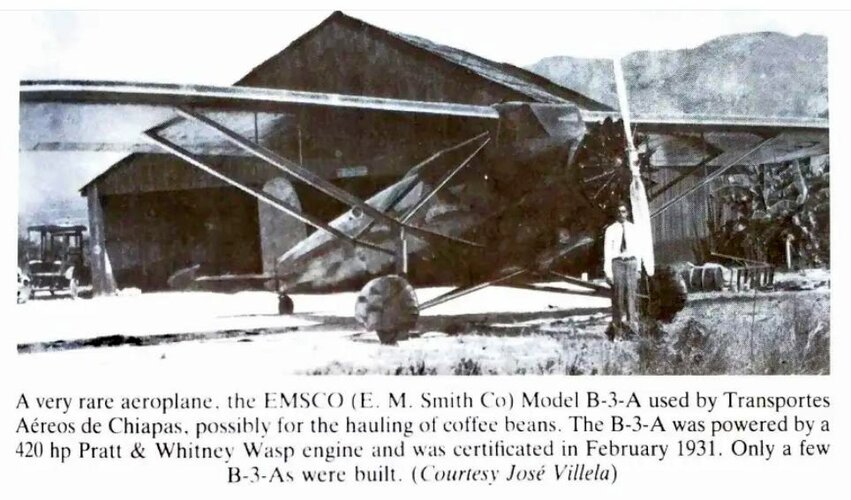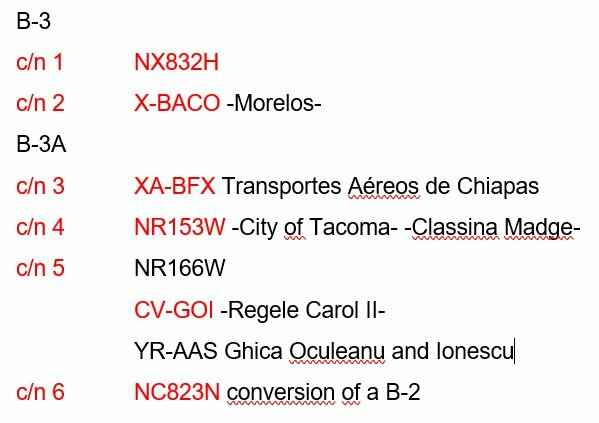- Joined
- 25 July 2007
- Messages
- 4,299
- Reaction score
- 4,198
EMSCO Aircraft Corporation - A Brief History
EMSCO Aircraft was a short-lived division of the E.M. Smith Company (best-known for producing equipment for the oil industry). In 1928 Smith's company bought the Zenith Aircraft Corporation of Long Beach, California, and transformed it into the EMSCO Aircraft Corporation.
Zenith had been formed to develop a range of highly efficient transport aircraft (all powered by Ryan/Siemens-Halske radial engines). [1] These transports were to be made in 3-, 6-, and 12-seat models.Only the latter type was actually built - as the Z-12 Albatross (NX3622 flew in the Fall of 1927, it had a 90' span).
The Albatross proved to be seriously underpowered and often reluctant to leave the ground. EMSCO took over Zenith and hired its Chief Designer - Charles F. Rocheville who inherited the Albatross rights (in 1931 Rocheville would be joined by Gerard F. Vultee). See Reply #5, below
While constructing a new facility at Downey, CA, the new EMSCO Aircraft Corp. continued Albatross development at the former Zenith plant in Long Beach. In 1929, EMSCO relocated to its new facility -- EMSCO Field at Downey.
A 1929 EMSCO brochure described a line-up of four current EMSCO aircraft types:
1 - EMSCO Challenger, an eight-place, cabin monoplane with 3 x Curtiss R-600 radials
2 - EMSCO B-3, an eight-place, cabin monoplane with a single P&W Wasp or Wright J-6
3 - EMSCO Cirrus, a two-place sport/training mid-wing monoplane with American Cirrus.
4 - EMSCO Amphibian, a six-place (5 + 1) twin-engined cabin monoplane.
The Amphibian seems to have been an unbuilt project. The other three types were built and are known by both EMSCO 'B' designations and their engine names. These are, respectively: the B-2 or 'Challenger', the B-3 or 'Wasp', and the B-4 or 'Cirrus'.
At some point prior to January 1930, the EMSCO Aero Engine Co. was also established to pursue diesel engine development under the former head of NACA's Langley Aeronautical Laboratory, Leigh M. Griffith. [2]
EMSCO continued to develop aircraft designs until 1931 [3] but was considered a 'hard luck' firm. As with many aviation companies, the Great Depression put paid to EMSCO Aircraft Corporation. Some of the design rights stayed with Rocheville (who continued to develop his Arctic Tern amphibian design into 1933).
The EMSCO facility at Downey was leased first in 1931 to Champion Aircraft Corporation of America, in 1933 to Security National Aircraft Corporation (Walter Kinner's attempt at aircraft production), before Vultee returned to this site in 1936.
[1] Zenith Aircraft Corporation was formed by Charles Focheville and Albin Peterson in August 1927. The Albatross was powered by 3 x 140 hp Ryan/Siemens-Halske radial engines.
[2] AFAIK, nothing came of this. The National Advisory Committee for Aeronautics' 15th annual Administrative Report (01 Jan 1930) lists "Emsco Aero Engine" as being in the midst of developing "compression ignition oil engines" for use in aircraft. Griffith was vice president and general manager of the EMSCO Aero Engine Company (he was 'engineer-in-charge' at Langley from 1917 to 1926).
[3] Sources vary on this date. Some claim that EMSCO Aircraft last until 1932. If so, the date listed for Champion's tenancy is inaccurate. If champion's lease was actually for 1932, that would make sense of the 1933 date for Kinner (Champion having only lasted seven months).
___________________________________________________
EMSCO Aircraft was a short-lived division of the E.M. Smith Company (best-known for producing equipment for the oil industry). In 1928 Smith's company bought the Zenith Aircraft Corporation of Long Beach, California, and transformed it into the EMSCO Aircraft Corporation.
Zenith had been formed to develop a range of highly efficient transport aircraft (all powered by Ryan/Siemens-Halske radial engines). [1] These transports were to be made in 3-, 6-, and 12-seat models.
While constructing a new facility at Downey, CA, the new EMSCO Aircraft Corp. continued Albatross development at the former Zenith plant in Long Beach. In 1929, EMSCO relocated to its new facility -- EMSCO Field at Downey.
A 1929 EMSCO brochure described a line-up of four current EMSCO aircraft types:
1 - EMSCO Challenger, an eight-place, cabin monoplane with 3 x Curtiss R-600 radials
2 - EMSCO B-3, an eight-place, cabin monoplane with a single P&W Wasp or Wright J-6
3 - EMSCO Cirrus, a two-place sport/training mid-wing monoplane with American Cirrus.
4 - EMSCO Amphibian, a six-place (5 + 1) twin-engined cabin monoplane.
The Amphibian seems to have been an unbuilt project. The other three types were built and are known by both EMSCO 'B' designations and their engine names. These are, respectively: the B-2 or 'Challenger', the B-3 or 'Wasp', and the B-4 or 'Cirrus'.
At some point prior to January 1930, the EMSCO Aero Engine Co. was also established to pursue diesel engine development under the former head of NACA's Langley Aeronautical Laboratory, Leigh M. Griffith. [2]
EMSCO continued to develop aircraft designs until 1931 [3] but was considered a 'hard luck' firm. As with many aviation companies, the Great Depression put paid to EMSCO Aircraft Corporation. Some of the design rights stayed with Rocheville (who continued to develop his Arctic Tern amphibian design into 1933).
The EMSCO facility at Downey was leased first in 1931 to Champion Aircraft Corporation of America, in 1933 to Security National Aircraft Corporation (Walter Kinner's attempt at aircraft production), before Vultee returned to this site in 1936.
[1] Zenith Aircraft Corporation was formed by Charles Focheville and Albin Peterson in August 1927. The Albatross was powered by 3 x 140 hp Ryan/Siemens-Halske radial engines.
[2] AFAIK, nothing came of this. The National Advisory Committee for Aeronautics' 15th annual Administrative Report (01 Jan 1930) lists "Emsco Aero Engine" as being in the midst of developing "compression ignition oil engines" for use in aircraft. Griffith was vice president and general manager of the EMSCO Aero Engine Company (he was 'engineer-in-charge' at Langley from 1917 to 1926).
[3] Sources vary on this date. Some claim that EMSCO Aircraft last until 1932. If so, the date listed for Champion's tenancy is inaccurate. If champion's lease was actually for 1932, that would make sense of the 1933 date for Kinner (Champion having only lasted seven months).
___________________________________________________



